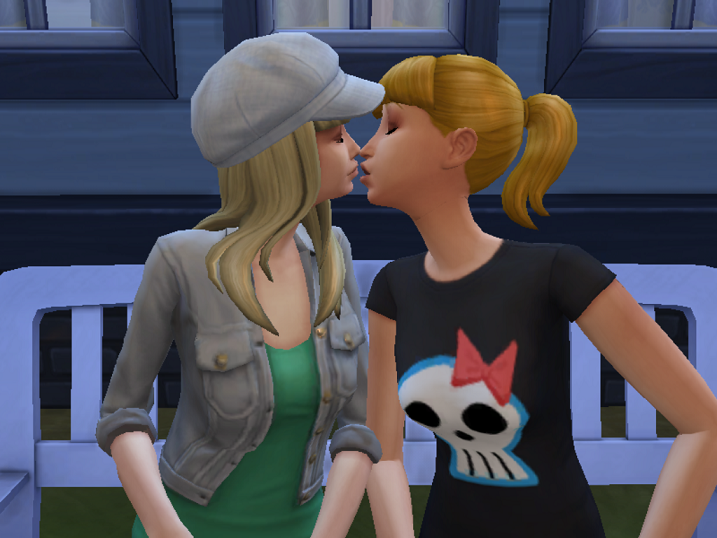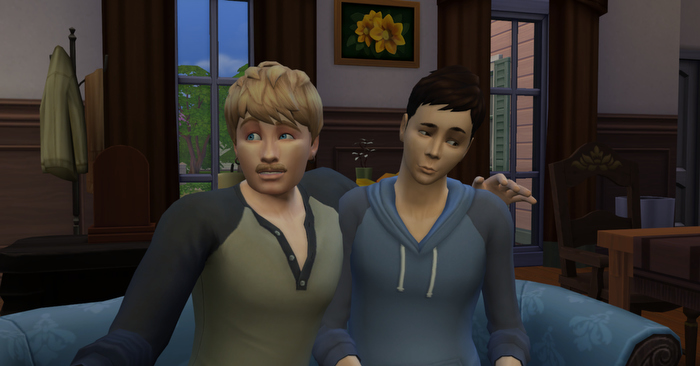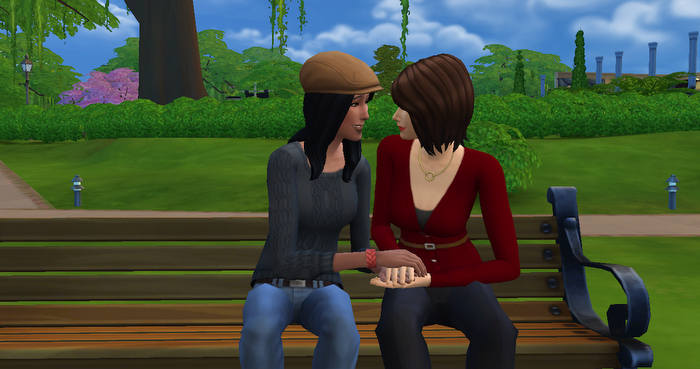When talking about The Sims, an adjective that could very accurately describe it is influential.
The follow-up project to creator Will Wright’s SimCity, the game was something that had never been tried before: an intimate simulation of real life where the player can act as either caretaker or doom-bringer for the characters in their charge. What they looked like, where they lived, who they interacted with, and when or how they died was all left up to the player to decide, and was intended to offer a realistic portrayal of the variety and choice inherent in real life.
Like all new IPs, The Sims was seen as a risky gamble before its release in 2000, and encountered several hurdles and road blocks all through its development. Yet, one of the game’s riskier inclusions — the ability to make characters LGBTQ — proved to be a saving grace, drawing positive publicity to the title when it needed it most. It continued to do so throughout the series’ lifetime as well, allowing it to establish itself as one of the better examples of diversity in character sexuality across the whole of the medium.
And it all started with a Crunch-Time fueled mistake.
Do or Die Dilemma
The story of how The Sims achieved this success, like a lot of other landmark games, started when the game was at its lowest point in development. For months leading up to E3, Patrick J. Barrett III and the rest of the development team at Maxis had been deep in crunch time trying to make The Sims’ E3 demo run smoothly. After years of struggling to show the game’s potential, it was their last chance to make a good impression with the media and consumers. They also needed to prove to EA that they could deliver on their risky new IP.
“EA really wanted Sim City. The Sims, they didn’t want, and it only survived as long as it did because it was Will Wright’s baby and they were afraid if they killed it he would leave,” Barrett said. “So about four months before E3, EA decided we were actually going to display The Sims at E3. It wasn’t planned, and if there wasn’t an interest at E3 they were killing the game.”
First conceptualized by Will Wright in 1993, the game had been trapped in development hell for years and was still stuck there when EA delivered their ultimatum. Even so, the team had fought to keep the game going through all of these hardships and a few within EA still held high hopes for the project.

“I think a number of us knew that there was something really special,” Patrick Buechner, the former PR manager for The Sims, said. “You had a gut feeling that you had something really fun and remarkable and different, but until you get it in the hands of players and the press, you never really know for sure.”
Ready or Not
After all that time though, the title was still far from ready.
“The game was unplayable. What we called it was the world’s best screen saver. The Sims was truly amazing to look at, but to actually play it was an awful experience,” Barrett said.
The team toiled away week after week and against all odds, they managed to pull together a demo in time for the show. Using a set of different scenarios, they provided what they thought would be the best possible representation of the game they could offer. As an added precaution, they programmed the scenarios around certain parameters to ensure nothing fell out of place while the player was in control.
“The game was put on rails, which means they weren’t really playing the game,” Barrett said. “They looked like they were playing the game, but everything was custom scripted so that exactly what was supposed to happen would happen. That way, they could demo it without any surprises or anything.”
For Barrett, this meant programming as many of the Sims as possible to stick to a specific script of actions. Each sim would go through the same motions in each play through, guaranteeing players and the press would see specific interactions at specific times.
Unfortunately, he hit a wall in the game’s wedding scenario, which had several dozen sims on screen at once.
“I didn’t have enough time to script all the wedding guests,” he said. “There were about 20 or 25 wedding guests, but only five of them were scripted, and the rest, they just used a regular simulator and did what they would normally do.”
The wedding saw sims interacting randomly or leaving the scenario area all together, but otherwise had no deal breaking flaws. Behind on work from taking care of other necessities for the demo, Barrett pushed this version through and hoped for the best while he made last minute touches and fixes to the game. He planned to arrive at the expo a day late as a result.
Simulated Lightning in a Bottle
Later that night, he received a call from EA’s executives asking him to bring a video preview of the game for their main attractions display. The Sims had become the runaway hit of the show.
When he arrived the next day, Barrett found EA’s section of the expo decked out to look like a coliseum. Demos for the latest editions of the company’s many sports titles were available to play, with previews for them playing across a jumbo screen set up high above the main floor.
The crowd, however, was gathered around The Sims’ booth set up to the side of this spectacle, so much so that Barrett couldn’t reach the two producers, Kana Ryan and Chris Trottier, who were in charge of showing off the demo.
“I couldn’t get up to them through the crowd,” he said. “It was really rather unbelievable.”
As an attendee was playing through the wedding scenario on the first day, two female sims had fallen in love and shared a kiss with each other. It had spread like wild fire that the game, which boasted the freedom to create any kind of characters you wanted, even allowed them to have their own sexual preferences, something truly never seen before in gaming. The Sims was truly a game for everyone.

With this, the game finally had a hook that drew in not only LGBTQ gamers, but the wider audience at E3. Other attendees were eager to see what the fuss was about, and weren’t disappointed when they saw the potential this new property held.
“I thought it was really amazing,” Vincent Lopez, former editor for IGN PC, said. “It felt like (Will Wright) was thinking in terms of adult issues, adult in terms of how you find happiness. It really did feel like something new to me.”
For those who had believed in and worked on the game, it was a dream come true.
“It was so rewarding and reassuring, and validating, once we got it in the hands of the press and people started responding to it so positively,” Buechner said. “Once people started playing it, it just started spreading by word of mouth.”
Accidentally Amazing
Remarkably enough, the kiss was an accident months in the making. When he was originally hired on in October 1998 to program the behaviors of the sims, Barrett was given old design documents to work off of. These documents included the allowance of same sex relationships, which had been scrapped to avoid controversy. Unaware of this, Barrett programmed the feature back into the game. When Will Wright saw this in passing, he simply said he was happy to see the feature included in the game again.
Though he was embarrassed to see the demos praised for going off rails in more ways than one, Barrett was happy to see the game find such widespread acclaim.
“For me at the time, it was kind of embarrassing, not because it was a same sex kiss but this game that all the attention was on didn’t do what it was supposed to do,” Barrett said, laughing.
Taking a Defining Stance
Following the show, The Sims had the proof it needed to stay in development. It also had a new dilemma: Among the online message boards, fans were eager to see the same sex options in the completed game. Likewise, press had reported on the feature, leaving the team to debate how it would be carried out in the final product.
“We really couldn’t remove it at that point,” Barrett said. “The genie was already out of the bottle. On the other hand, we really couldn’t leave it the way it was.”
In terms of programming, every sim functioned as bisexual. At any given time, they could find themselves attracted to any other sim, which Barrett and the other team members felt didn’t seem accurate. After some debate, the team decided to adjust the sims programming to determine sexual preference based on repeated actions. If a sim engaged in romantic interactions with same sex characters, opposite sex characters or a mix of the two repeatedly over time, they would eventually adopt that as their natural preference.
Though there were still some concessions made – same sex characters weren’t able to get married and were referred to as “roommates” – the feature was made permanent and readily available to players. Now the team just had to wait and see how the world responded.
A Legacy of Progress
Upon release, the game was readily accepted and received heaps of praise and accolades. Many heralded its detailed character and home creation, the depth of its systems and, yes, even the inclusion of same sex relationships. For several fans, it was a way to learn about different sexual preferences in a safe way, or for the first time.
“The Sims helped me a lot,” reddit user iErgunn said. “I was only 5 years old when the Sims came out, but I remember it was a huge part of my childhood since same sex relationships were possible. The connotation that you could just do that played a huge role in my perception of sexuality, that it was not wrong but one of the most normal things ever.”
To others, the availability of the feature served a larger purpose.
“A lot of trying to push for gay rights, to push for equality has been about visibility,” Lopez said. “That’s what that game was trying to do. By making it a non-issue, it really made it such a big deal because it didn’t have to make a statement. It just allowed you to do what you want, which is all people want in life. They just want the freedom to follow their own path.”

In the months following the game’s release, the team received a steady stream of fan mail and letters of appreciation, many of them from fans who had found a sense of acceptance through the game. Even in the wider gaming audience, the title was a critical darling, with most every outlet heaping praise on the game and standing by its commitment to diversity.
Too Hot for the ESRB
The only real challenge to its inclusion came when the game’s expansion pack, Living Large, was given an M-rating, whereas the original game had been given a T-rating. The team had been prepared for this due to the inclusion of the “Love Bed,” which allowed sims to have sex with one another. Barrett was prepared to remove the explicit elements of the feature if necessary, and offered to do so after the rating was handed down. However, the rating board had made the decision for a different reason.
“When we went to the ESRB on The Sims 1, they didn’t have any guidelines on same sex support because no game had ever done it,” Barrett said. “So we got a T-rating. Well, we didn’t know, but the ESRB corrected that after the game shipped and same sex support was an automatic M.”
This posed a serious problem. Fans had contacted the team regularly about how much they loved the feature’s inclusion, and their fears that it could be removed in later versions. On top of this, the team was proud of its inclusion and wanted to stand by an integral part of the game that had been intended from the beginning.
Luckily for them, EA felt the same way.
“For EA, once a game ships, that’s just how it is,” Barrett said. “If it’s in the first game, it’ll be in every version of the game. That’s just how they are, they never had any problem with it.”
Through a lot of effort, determination and standing their ground, EA was able to convince the ESRB to maintain the game’s T-rating, grandfathering the original support for its LGBTQ content into Living Large and down to future installments of the series without bumping up their ratings from T.
“EA fought,” Barrett said. “They fought the ESRB, and they fought hard.”
Waiting to Pass the Torch
In the years following its release, The Sims has only grown in its influence. The game remains a juggernaut within the gaming landscape, and its support of LGBTQ characters remains an integral part of its design. Likewise, it’s not the only game out there with support for LGBTQ relationships in their content: Fable, a popular RPG series on Xbox and Xbox 360, allowed players to have gay and lesbian relationships, and The Last of Us Part II recently made waves with a lesbian kiss of its own at E3 2018. Likewise, a slew of indie titles such as Night in the Woods have offered characters with believable and realistic LGBTQ relationships.
For Barrett though, there still remains a lot to be done in terms of progressing representation in the same way The Sims did.
“I don’t think the industry as a whole, or actually at all, has picked up the ball from where The Sims left it,” Barrett said. “It’s really disappointing because The Sims shipped 17 years ago and the rest of the games in the industry haven’t caught up to The Sims yet.”
All the same, progress is being made in better representing LGBTQ relationships in games, however slowly; and, so long as series like The Sims continue to strive toward greater heights, there may someday be more games out there that help people see acceptance of sexual identities as more than just a simulation.
Keenan McCall
Latest posts by Keenan McCall (see all)
- Madden 19’s Colin Kaepernick Censorship Didn’t Need to Happen – August 7, 2018
- How The Sims Became a Champion for LGBTQ Representation in Gaming – July 24, 2018
- Super Lesbian Animal RPG Is A Treasure In The Making – March 9, 2018

Leave a Reply